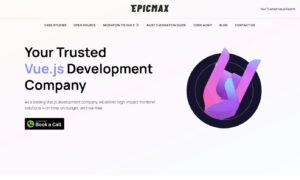As we journey through 2023, the landscape of modern web development continues to evolve, with JavaScript frameworks and Progressive Web Applications (PWAs) taking the limelight. This article aims to demystify these pivotal aspects of modern web development and provides an insightful deep dive into their potential.
JavaScript Frameworks: The Cornerstone of Modern Web Development
JavaScript frameworks have become an integral part of contemporary web development. They provide a structured and efficient approach to building web applications, offering ready-to-use components, efficient data binding, and often a more maintainable codebase.
Three JavaScript frameworks dominate the scene: React, Vue.js, and Angular. Each of these has its strengths and caters to different development styles and project needs.
React, developed and maintained by Facebook, is known for its component-based architecture and virtual DOM, which optimizes re-rendering and enhances performance. Its rich ecosystem and the backing of a large community make React a go-to choice for many developers.
Vue.js, on the other hand, is praised for its simplicity and flexibility. It provides an incremental adoptable architecture that focuses on declarative rendering and component composition. Vue’s gentle learning curve makes it a popular choice for teams transitioning from vanilla JavaScript or jQuery.
Angular, a product of Google, is a full-fledged MVC (Model-View-Controller) framework. It boasts powerful features like two-way data binding, dependency injection, and an extensive set of tools and components. Angular is typically favored for large-scale, enterprise-level applications.
Progressive Web Applications: Bridging the Gap Between Web and Mobile
Progressive Web Applications (PWAs) are another significant trend in modern web development. A PWA uses modern web capabilities to deliver an app-like experience to users. These applications can be loaded on the server, work offline, and are installable on the home screen without going through app stores.
One of the core principles of PWAs is the progressive enhancement, which means that the core webpage content should be accessible to all browsers while the advanced functionalities are available to capable browsers. This approach ensures that PWAs are usable regardless of network conditions or device capabilities, making them a truly universal application solution.
JavaScript Frameworks and PWAs: A Power Duo
How do JavaScript frameworks fit into the PWA landscape? As it turns out, quite seamlessly.
Frameworks like React, Vue.js, and Angular have robust support for building PWAs. They offer developers tools and libraries that streamline the process of creating PWAs, handling aspects like offline functionality, resource caching, and background syncs.
For instance, developers can utilize Create React App (CRA), which comes with built-in PWA support. Angular provides service workers for seamless offline data access and management. Vue.js offers a PWA plugin that generates a service worker file automatically and injects the necessary code into your application.
Looking Ahead: The Future of Web Development
As we explore the depths of 2023, it’s clear that JavaScript frameworks and PWAs form a potent combination that’s shaping the future of web development.
JavaScript frameworks, with their high performance, maintainability, and strong community support, continue to be essential tools in a developer’s toolkit. Meanwhile, PWAs are bridging the gap between web and mobile apps, offering users a seamless, app-like experience without the need for app stores.
The synergy between these technologies presents exciting possibilities. Developers can leverage the power and flexibility of JavaScript frameworks to build PWAs that work seamlessly across devices, offline and online. This powerful duo offers an unrivaled user experience, combining the best aspects of web and mobile applications.
As we continue to demystify modern web development, it’s evident that our journey is far from over.

































